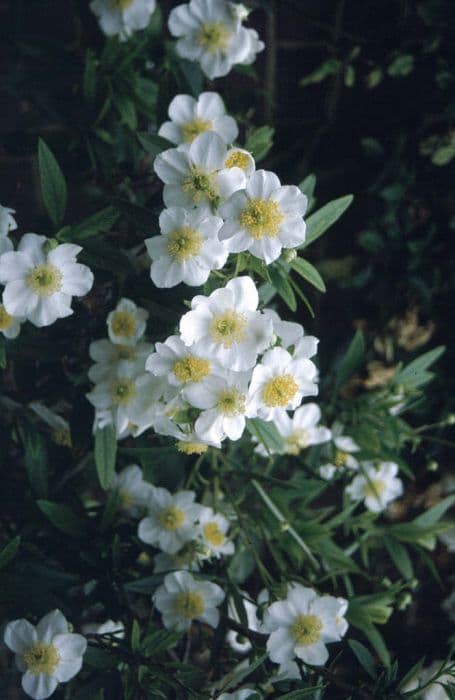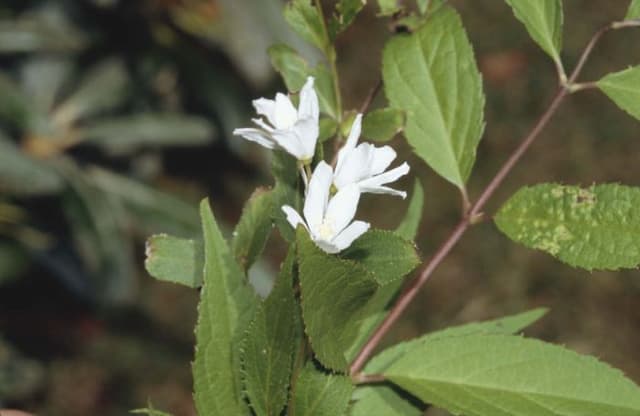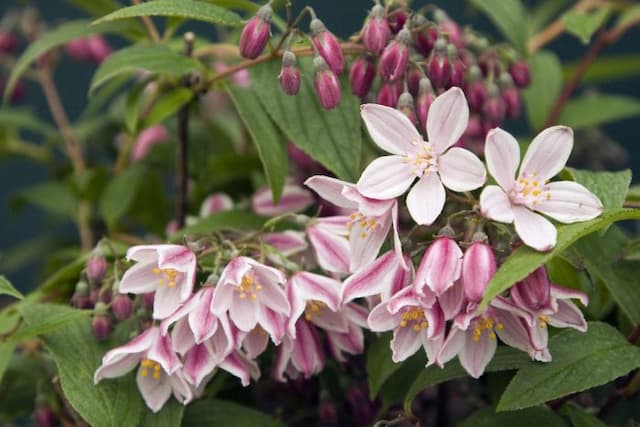Bigleaf Hydrangea Hydrangea macrophylla Love = 'Youme H1917' (PBR) (H/d)
![hydrangea [Love]](/_next/image?url=https%3A%2F%2Fplants-admin.emdemapps.com%2Fimages%2Fplants%2F%2Fimages%2F604b63d483d94.png&w=3840&q=75)
ABOUT
The Hydrangea macrophylla Love, commonly known as the bigleaf hydrangea, is a stunning ornamental shrub that's notable for its enchanting blooms. This particular cultivar, often referred to simply as 'Love', presents with striking, large flower heads that are made up of numerous small florets. These flowers possess a unique ability to change color depending on the soil's pH levels, ranging from bold pinks in alkaline soils to vibrant blues in more acidic conditions. The lush green leaves serve as a complementary backdrop to the vibrant flowers, with their broad, ovate shape and serrated edges adding to the plant's overall lush appearance. Additional attractiveness comes in the form of its robust stems that hold the flower heads aloft, creating a picturesque display ideal for gardens and arrangements.
About this plant
 Names
NamesSynonyms
Bigleaf Hydrangea, French Hydrangea, Lacecap Hydrangea, Mophead Hydrangea, Penny Mac, Hortensia.
Common names
Hydrangea macrophylla Love, Hydrangea macrophylla 'Youme H1917'.
 Toxicity
ToxicityTo humans
The common name for Hydrangea macrophylla Love = 'Youme H1917' (PBR) (H/d) is Hydrangea. Hydrangeas are considered to be mildly toxic if ingested due to the presence of cyanogenic glycosides found in the plant’s leaves and flower buds. If parts of the plant are eaten, symptoms of poisoning can include gastrointestinal upset, such as nausea, vomiting, and diarrhea. In some rare cases, more severe symptoms could occur, such as dizziness, lethargy, or confusion due to cyanide release in the body. However, serious toxicity is uncommon, and ingestion of hydrangea typically results in minimal toxicity.
To pets
Hydrangea, which is the common name for Hydrangea macrophylla Love = 'Youme H1917' (PBR) (H/d), is also poisonous to pets. Similar to their effects on humans, hydrangeas contain cyanogenic glycosides, and ingestion by pets can lead to symptoms of toxicity. These can include vomiting, diarrhea, and depression. While the plant is not generally considered highly toxic to pets, consumption of large amounts could potentially lead to more severe poisoning and symptoms such as difficulty breathing or increased heart rate. If a pet ingests hydrangea, it is recommended to seek veterinary attention.
 Characteristics
CharacteristicsLife cycle
Perennials
Foliage type
Deciduous
Color of leaves
Green
Flower color
Pink
Height
4 feet (1.2 meters)
Spread
4 feet (1.2 meters)
Plant type
Shrub
Hardiness zones
6
Native area
Japan
Benefits
 General Benefits
General Benefits- Attractive Flowers: Features large, eye-catching blooms that add a splash of color to gardens and landscapes.
- Long Blooming Period: Typically flowers from early summer to late autumn, providing a long season of visual interest.
- Variety of Colors: Blooms come in a range of colors that can shift based on the soil pH, giving gardeners a variety of color options within a single plant.
- Popular for Cutting: The flowers are ideal for creating striking floral arrangements and bouquets.
- Garden Versatility: Suitable for planting in borders, containers, or as a focal point in a garden setting.
- Easy to Grow: Considered low maintenance and easy to care for, making it ideal for both novice and experienced gardeners.
- Winter Hardiness: Depending on the climate zone, it can be hardy and withstand colder temperatures, which is beneficial for year-round garden structure.
- Attracts Pollinators: The flowers can attract bees, butterflies, and other beneficial pollinators, aiding in the health of the garden ecosystem.
- Durable in Seaside Gardens: With proper care, it is known to be capable of tolerating the coastal environment including salt sprays.
- Seasonal Foliage Interest: Leaves can provide additional interest with color changes through the growing season.
 Medical Properties
Medical PropertiesThis plant is not used for medical purposes.
 Air-purifying Qualities
Air-purifying QualitiesThis plant is not specifically known for air purifying qualities.
 Other Uses
Other Uses- Floral ink: Petals of the Hydrangea can be used to make a natural ink for art or craft purposes, with shades depending on the pH levels of the soil they grow in.
- Dye for textiles: Similarly, the flowers can be used to naturally dye fabrics, yielding delicate colors that are especially sought after in bespoke fashion creations.
- Photography backdrop: With their lush, broad blooms, hydrangeas can provide a romantic and full backdrop for portraits and macro photography.
- Pressed flower crafts: The individual florets of the Hydrangea can be pressed and used for creating bookmarks, cards, or decorative frames.
- Watercolor painting: Juice from the petals can be used by artists for a natural watercolor paint, providing a unique spectrum of hues.
- Culinary garnish: Although not commonly eaten, the vibrant flowers can be used to add a splash of color to salads or desserts in gourmet cuisine (but it's important to ensure they have not been treated with pesticides or harmful chemicals).
- Education: In botanical and horticultural studies, the Hydrangea serves as a prime example of how soil pH influences flower color, providing an interesting subject for educational experiments.
- Wedding confetti: Dried petals can be tossed as natural and biodegradable confetti at weddings or celebrations.
- Paper making: The fibrous material in Hydrangea stems can be incorporated into handmade paper recipes for added texture and visual interest.
- Art installations: Due to their large and colorful flower heads, hydrangeas can be used in large-scale art installations to create immersive sensory experiences.
Interesting Facts
 Feng Shui
Feng ShuiThe Hydrangea is not used in Feng Shui practice.
 Zodiac Sign Compitability
Zodiac Sign CompitabilityThe Hydrangea is not used in astrology practice.
 Plant Symbolism
Plant Symbolism- Heartfelt emotions: Hydrangea symbolizes the expression of deep emotions and heartfelt understanding, often associated with gratitude and profound sincerity.
- Gratitude: As a gift, it is a way to express thanks or appreciation, showing gratitude for being understood.
- Vanity and boastfulness: In some cultures, hydrangeas symbolize vanity and boastfulness due to their abundance of petals and showy appearance.
- Apology: The hydrangea can also represent an apology, offering a way to express regret or to ask for forgiveness.
- Abundance: The lush blooms signify abundance and prosperity, which can symbolize the ability to multiply and grow.
- Fourth wedding anniversary: Hydrangeas are a traditional gift for the fourth wedding anniversary, symbolizing appreciation and enduring love between a couple.
 Water
WaterBigleaf hydrangeas, including Hydrangea macrophylla Love, require consistent moisture, so water them once or twice a week. The soil should be kept moist, but not soggy, to a depth of about 6 inches. During hot or dry periods, you may need to water more frequently to prevent the leaves from wilting. A general rule is to provide about 1 gallon of water per watering session for each plant, adjusting as needed for rainfall and temperature variations.
 Light
LightBigleaf hydrangeas, such as the Hydrangea macrophylla Love, thrive in dappled shade or morning sun with afternoon shade. Avoid placing them in full afternoon sun, as this can cause stress and wilting. A spot that receives bright, indirect light for most of the day is ideal. East-facing locations where the plant can get gentle morning sunlight and shade from the harsher afternoon rays are typically best for these hydrangeas.
 Temperature
TemperatureBigleaf hydrangeas like Hydrangea macrophylla Love prefer temperatures between 65°F and 75°F for optimal growth. They can survive temperatures as low as 5°F for short periods once established and properly mulched, but prolonged exposure can damage the plant. In summer, they should be protected from extreme heat above 95°F, which can cause stress and harm to the plant.
 Pruning
PruningPrune Bigleaf hydrangeas like Hydrangea macrophylla Love shortly after they finish blooming in summer, as they bloom on old wood. Remove faded flowers and any dead or damaged branches to encourage healthy growth and improve the plant's shape. Pruning too late in the season can remove developing flower buds for the next year, so timing is crucial.
 Cleaning
CleaningAs needed
 Soil
SoilBigleaf hydrangeas like 'Youme Love' thrive in well-draining, moist soil enriched with organic matter. A soil pH of 5.5 to 6.5 is ideal to maintain vibrant bloom color; more acidic conditions can turn the flowers blue, while alkaline soil tends to make them pink.
 Repotting
RepottingBigleaf hydrangeas like 'Youme Love' should generally be repotted every 2-3 years to refresh the soil and accommodate root growth. In spring, before active growth begins, is the best time for repotting.
 Humidity & Misting
Humidity & MistingBigleaf hydrangeas like 'Youme Love' prefer high humidity environments. A relative humidity level around 60% is ideal, but they can tolerate a range between 50% to 70% without issues.
 Suitable locations
Suitable locationsIndoor
Place 'Youme Love' hydrangea in bright, indirect light indoors.
Outdoor
Plant 'Youme Love' hydrangea in partial sun with shelter.
Hardiness zone
6-9 USDA
 Life cycle
Life cycleThe life of a Hydrangea macrophylla, commonly known as Bigleaf Hydrangea, begins with seed germination, where it requires warm and moist conditions to sprout. Once sprouted, the seedling grows into a juvenile plant with characteristic large, glossy leaves and begins to develop a woody stem structure. As the hydrangea matures, it enters the vegetative stage where it focuses on leaf and stem growth. The flowering phase follows, typically in early to mid-summer, where it produces large, showy flower heads that can be pink, blue, or purple depending on soil pH. After pollination, if it occurs, the flowers give way to seed capsules that mature by autumn, allowing the plant to reproduce sexually, although hydrangeas often propagate through vegetative cuttings. Finally, the plant enters dormancy in the winter, reducing metabolic activities to survive cold conditions until the cycle recommences in spring.
 Propogation
PropogationPropogation time
Spring to early summer
Propogation: The most popular method of propagating the Hydrangea macrophylla, commonly known as bigleaf hydrangea, is through softwood cuttings. This is typically done in late spring or early summer when the plant's new growth is still tender and green but has not fully hardened. Gardeners cut a 4 to 6 inch (about 10 to 15 centimeters) length of stem that includes several leaves and at least one node, or the point on a stem where leaves are attached. The bottom leaves are removed, and the cut end is dipped in rooting hormone before being planted in a moist potting mix. The cutting is then placed in indirect light and kept consistently moist until roots develop, which generally takes about 2 to 4 weeks. After rooting, the new hydrangea plant can be transferred to a larger pot or planted directly in the garden.







![Hydrangea [Strong Annabelle]](/_next/image?url=https%3A%2F%2Fplants-admin.emdemapps.com%2Fimages%2Fplants%2F%2Fimages%2F604b54db37d34.png&w=640&q=75)

